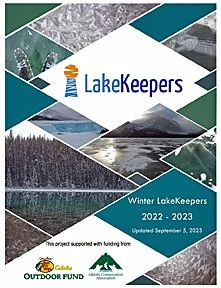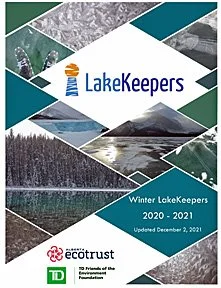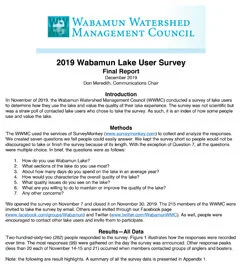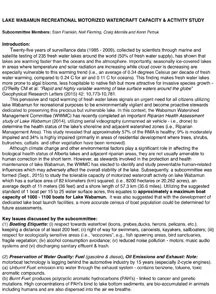Each winter the WWMC works with the Alberta Lake Management Society to do water quality monitoring of Wabamun Lake throughout the winter. The linked ALMS report summarizes the data collected from variety of lakes from across the province, including Wabamun.
2022-2023 ALMS Winter LakeKeepers Report
2022-ALMS LakeWatch Report
LakeWatch reports are designed to summarize basic lake data in understandable terms for the widest audience, and are not meant to be a complete synopsis of information about specific lakes. Additional information is available for many lakes that have been included in LakeWatch, and readers requiring more information are encouraged to seek those sources.
2021-2022 ALMS Winter LakeKeepers Report
2022-NSWA Report-Riparian Health of Wabamun Lake
Riparian assessments are tools that estimate how healthy a riparian area is and how that might correspond to ecological function within a watershed. The results can be used to support decisions about where conservation or restoration is needed to help improve the natural functions of riparian areas.
2021-ALMS LakeWatch Report
LakeWatch reports are designed to summarize basic lake data in understandable terms for the widest audience, and are not meant to be a complete synopsis of information about specific lakes. Additional information is available for many lakes that have been included in LakeWatch, and readers requiring more information are encouraged to seek those sources.
Watershed Management Plan Videos
2020-2021 ALMS Winter LakeKeepers Report
2020-ALMS LakeWatch Report for Wabamun Lake
LakeWatch has several important objectives, one of which is to collect and interpret water quality data from Alberta’s Lakes. Equally important is educating lake users about aquatic environments, encouraging public involvement in lake management, and facilitating cooperation and partnerships between government, industry, the scientific community and lake users.
2020-Summary of Wabamun Watershed Management Plan
2020-Wabamun Lake Watershed Management Plan
2019-2020 ALMS Winter Lake Keepers Report
2019-ALMS LakeWatch Report for Wabamun Lake
LakeWatch has several important objectives, one of which is to collect and interpret water quality data from Alberta’s Lakes. Equally important is educating lake users about aquatic environments, encouraging public involvement in lake management, and facilitating cooperation and partnerships between government, industry, the scientific community and lake users. LakeWatch reports are designed to summarize basic lake data in understandable terms for the widest audience, and are not meant to be a complete synopsis of information about specific lakes.
2019-Lake User Survey Summary Report
In November of 2019, the Wabamun Watershed Management Council (WWMC) conducted a survey of lake users to determine how they use the lake and value the quality of their lake experience. The survey was not scientific but was a straw poll of contacted lake users who chose to take the survey. As such, it is an index of how some people use and value the lake. This report summarizes the results. The Final Report includes this summary plus more detailed summaries of the data in the appendices.
2019-Lake User Survey Final Report (1.9 mb)
In November of 2019, the Wabamun Watershed Management Council (WWMC) conducted a survey of lake users to determine how they use the lake and value the quality of their lake experience. The survey was not scientific but was a straw poll of contacted lake users who chose to take the survey. As such, it is an index of how some people use and value the lake.
2018-Drone Fly Over Report - 2018 Ice Heave Damage
2016-Lake Wabamun Recreational Activity Assessment Study
2015-Wabamun BATHTUB Report
BATHTUB is an empirical eutrophication model developed by the United States Army Corps of Engineers for use on reservoirs and lakes (Walker 2006). The model was designed to calculate water and nutrient mass balances that replicate lake processes over a broad time scale. Besides simulating current conditions, BATHTUB can be used as a planning and educational tool for evaluating future watershed development/restoration scenarios.



















